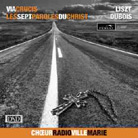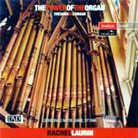August 2004
By now, many of you are already familiar with the superb recordings Fidelio Audio has issued over the past few years. I’ve raved about discs such as Doreen Smith’s A Tribute To Julie, the Loscher Trio’s Shadows, and the Marc Vallee Trio’s Hamadryade. Those titles don’t ring a bell? Well, where ya been? I was captivated by each, and gave them a high recommendation here in the past (take a look in the music archives if you’re curious). Another disc that I found to be special was Fidelio Audio’s Red Book release of Theodore Dubois’ Les Sept Paroles du Christ (The Seven Last Words Of Christ). However, this year Fidelio has upped the ante by re-releasing this recording on hybrid multichannel SACD, and adding Franz Liszt’s Viacrusis to double your pleasure. Liszt and Dubois wrote their respective compositions to glorify God. Both deal with the time period between Holy Thursday and Easter Sunday, from the Last Supper to the death and resurrection of Christ. They are organ-with-choir based, so it was natural to combine them on this SACD. Finally, they were recorded in the same venue -- the Eglise du Tres-Saint-Nom-De-Jesus, Montreal, Canada -- with the same organist, Regis Rousseau, and used the same choir, the Radio Ville Marie. The soloists differ, as do the recording methods. The Dubois was recorded on analog tape in 2001, the Liszt is a pure DSD recording in 2003. Both Viacrusis and Les Sept Paroles du Christ are world-class performances. They may have a leg up on any of their recorded competition due to Fidelio Audio’s releasing them on this hybrid multichannel SACD. After taking my initial listen, I sincerely doubt that there are any better recordings of these works (performance is another matter -- that’s up to individual taste) available. SACD’s wide frequency response, together with its expanded dynamics over that of Red Book CD, allow the organ to fully reveal all its power (provided, of course, that your system is up to plumbing the instrument’s depths) and it lets the choir and soloists bloom. The stereo SACD layer is superb. Spread before you are the organ and the choir, one well behind the other. Soloists are set front and center, their voices fully separate from both the choir and the organ. Most impressive is the way Fidelio Audio captured the organ. On Viacrusis, I could discern the difference between the air in the church that was pumped through the pipes of the organ and the acoustic air of the recording venue itself. Each note wafts into the further reaches of the church acoustic as it fades away. If you move along to the multichannel layer of this hybrid SACD, you’ll gain an even greater appreciation for the compositional skills of Liszt and Dubois, as well as the ability of organist Rousseau. Fidelio’s engineer, Rene La Flamme, has succeeded admirably in giving the listener a 360-degree soundfield. The music wraps around you, enveloping you within it, allowing you to fully feel the passion both composers invested in their works. The Red Book layer of this disc is fully the equal of any on the market, so non-hi-rez digital listeners don’t have to feel left out. For those who searched out a copy of the Dubois CD based on my recommendation, I can only say I’m sorry. I’m afraid you’re going to be shelling out once again. This disc is simply too good, too well packaged, and too well recorded -- thanks to the inclusion of the Liszt -- to pass up. If you’re an organ fanatic, finding well-recorded examples of the king of instruments, especially on SACD, has been tough sledding (as we say in these parts). So release of The Power of the Organ will come as something akin to a late March snow storm. The bounty begins with the recording itself, which is pure DSD. Another point in its favor is that this album is being released in conjunction with Musicus, another fine Canadian recording label, examples of whose oeuvre have appeared on the Montreal Festival Of Sound & Image show's discs for the past two years. The format of this disc is unique enough that it deserves mention of and by itself. The organ featured here is in the Notre-Dame Cathedral in Ottawa, Canada and was built by Joseph Casavant in 1850. In its original form it was an 18-stop, 1063-pipe instrument. Subsequent additions over the intervening years have expanded it and it now contains 72 stops (96 ranks in eight divisions over three manuals and pedals), and has a 256-level memory combination system. The keyboardist for this recording is the Notre-Dame Cathedral’s present titular organist of the Cathedral (circa 2002), Rachel Laurin. As should be expected, her technical mastery is formidable. The engineer for this November 12, 2003 recording was Jean De La Durantyne of Musicus. The program that makes up this disc is a mixture of classic organ works, by Bach, Liszt, Wider, and Franck and some lesser-known organ composers like Gigout, Vierne, Daquin, Clerambault, and Boellmann. By setting up the program in this manner, Fidelio has created an SACD of interest, not just a recording of the same old repertoire. Also, the playing time comes in at (and here’s where the formatting gets interesting) 83:51 for stereo SACD, 77:41 for PCM CD, and 8:53 for multichannel SACD. And yes, you read that correctly, there are three different playing times, depending on which layer you’re listening to. This arrangement may cause some confusion, so I’ll attempt to explain it. The only discomfiture you may experience will come on your initially loading the disc in your player. If your player defaults to multichannel, you’re going to wonder why the playing time is so short (as I initially did). There are only two multichannel tracks, Bach’s "Choral: Jesus, Que Ma Joie Demeure" and Liszt’s "Ave Maria D’Arcadelt," hence, the short playing time. The stereo SACD layer contains the longest playing time; all the tracks on this recording are included on that layer. The PCM CD layer is missing one track from the stereo hi-rez layer (Widor’s "Adante Cantabie"). This omission shouldn't be a serious detriment to a non-hi-rez audiophile's listening pleasure, but you may feel free to disagree. Since the stereo SACD layer contains all tracks, you will simply have to manually switch to the stereo layer to hear the disc in its entirety. Also, since the multichannel tracks are duplicated on the stereo layer, comparisons between the two formats are easy. Sonically, The Power of the Organ is a knockout. It will fulfill all your dreams and desires for a true DSD organ recording. The full power of the Notre-Dame organ is conveyed therein. All three layers, PCM CD, stereo and multichannel SACD, do a masterful job at re-creating the feel of being at the recording session. About the only thing that will hold you up from reaching full enjoyment will be the limitations imposed by the low-frequency extension of your loudspeaker system. As a bonus, just wait until you hear how spookily real the church bells during the Liszt cut sound. If you love full organ music, each of these discs is a must own. Each will bring a smile to the face of any lover of the king of instruments, and both will offer your system a workout, especially in the subterranean depths. Kudos to Fidelio Audio and Musicus for allowing us to experience these superb recordings, though, given Fidelio’s past track record, it probably shouldn’t come as a surprise. But for those of you who have already purchased the Dubois on CD, reach deep into your wallets, because you can’t afford to pass up this new high-resolution reissue of that work. GO BACK TO: |
 Liszt - Via
Crucis; Dubois - Les Sept Paroles du Christ
Liszt - Via
Crucis; Dubois - Les Sept Paroles du Christ Rachel Laurin - The Power of the Organ
Rachel Laurin - The Power of the Organ Oh, this one’s
going to cost you!
Oh, this one’s
going to cost you!